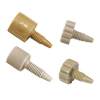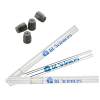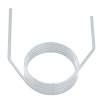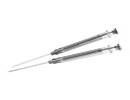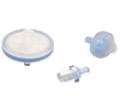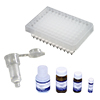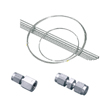6. How to Prolong Column Lifetime
Column lifetime depends on the analytical conditions and the storage method. Here we introduce the causes of column damage and how to deal with them.
6-1. Dirt Accumulation in the Column
Dirt in the column distorts peak shapes. In this case, please try column wash first. For example for reversed-phase columns, follow the flowchart on the right. Methanol and acetonitrile are generally used solvents in the washing process, but if the dirt cannot be washed out, 2-propanol or acid-containing organic solvents may remove it. If dirt accumulation often happens, the use of a guard column is recommended. It is sometimes effective to remove sample matrix by pre-treatment such as solid phase extraction. Note that insufficiently end-capped columns tend to accumulate dirt more easily.


6-2. Clogging of the Column Filters
There are filters at either end of the column to prevent the packing material from leaking out. Insoluble compounds in the sample or the mobile phase can clog these filters. In this case, the column pressure gradually increases, and eventually the column pressure becomes too high to deliver the mobile phase. Once a sign of this phenomenon is observed, filter the sample or the mobile phase before analysis. The analytical column can also be protected by attaching a guard column before it. In general, the larger the silica particles are, the larger the filter mesh becomes. This makes it easier for insoluble compounds to pass through the filters. Therefore, it is an option to choose a column packed with large particles to avoid filter clogging.
6-3. Dissociation of the Functional Groups
Highly concentrated acids or bases sometimes shorten retention times. This is probably due to dissociation of the functional groups from the surface of the packing material. Since re-functionalization is impossible, keep the pH and temperature within the recommended values. For long-term storage, it is recommended to replace the solvent in the column with an organic solvent without acids or bases and plug the column ends.
6-4. Degradation of the Packing Material
Some solvents degrade the packing materials. For example, basic solutions gradually dissolve silica by hydrolysis. Polymers can be swollen, depending on the combination of the material and the solvent. In general, degradation of the packing material increases the column pressure and lowers the plate number. Therefore, please keep the operating conditions shown in the instructions, such as pH range, in order not to damage your column because degraded packing materials cannot be recovered. Higher hydrophobicity of the packing material generally prevents hydrolysis of silica. Under basic conditions, ODS columns are superior to C8 columns in this sense, and among ODS columns, the higher the carbon load is, the longer the column lifetime will be.
6-5. Change in the Packing State
The packing state of the particles in the column can be changed when the column pressure exceeds the maximum operating pressure or fluctuates suddenly. Defects in the packing state makes the flow of the mobile phase irregular, which results in distorted peaks or lower plate numbers. One of the measures to prevent the change in the packing state is to keep the column pressure far below the maximum operating pressure. For example, even among ODS columns having the same column dimensions (i.e., I.D. and column length) and particle size, the column pressure depends on the packing material. Choosing a column which generates as low pressure as possible can minimize the risks to damage the column by exceeding the maximum operating pressure by accident.



